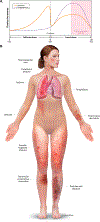Progestogen Hypersensitivity
- PMID: 37579875
- PMCID: PMC10841326
- DOI: 10.1016/j.jaip.2023.07.050
Progestogen Hypersensitivity
Abstract
Progestogen hypersensitivity (PH) is a heterogeneous disease characterized by diverse cutaneous manifestations, bronchospasm, and/or anaphylaxis. Possible triggers include ovarian progesterone and exogenous progestogens. The timing of symptoms is critical to diagnose PH: during the luteal phase of the menstrual cycle for the endogenous form and after exposure to progestins for exogenous PH. Diagnostic modalities such as progesterone skin testing have low sensitivity and specificity for PH. When exogenous PH is suspected, the allergist should consider a progestogen challenge. Treatment strategies should be tailored for each patient, including symptom-directed therapies, ovulation suppression, and progesterone desensitization. Future studies should explore the mechanisms of PH, validation of diagnostic criteria, and standardization of treatment strategies.
Keywords: Autoimmune progesterone dermatitis; Endocrine allergy; Infertility; Menstrual cycle; Progesterone; Progestin; Steroid hormone allergy.
Copyright © 2023 American Academy of Allergy, Asthma & Immunology. Published by Elsevier Inc. All rights reserved.
Conflict of interest statement
Conflicts of interest:
The authors declare that they have no conflict of interest.
Figures



Similar articles
-
Progestogen Hypersensitivity: Heterogeneous Manifestations with a Common Trigger.J Allergy Clin Immunol Pract. 2017 May-Jun;5(3):566-574. doi: 10.1016/j.jaip.2017.01.019. J Allergy Clin Immunol Pract. 2017. PMID: 28483311 Review.
-
Progestogen Hypersensitivity in 24 Cases: Diagnosis, Management, and Proposed Renaming and Classification.J Allergy Clin Immunol Pract. 2016 Jul-Aug;4(4):723-9. doi: 10.1016/j.jaip.2016.03.003. Epub 2016 Apr 16. J Allergy Clin Immunol Pract. 2016. PMID: 27090357
-
Progestogen Hypersensitivity.Curr Allergy Asthma Rep. 2018 Jan 19;18(1):1. doi: 10.1007/s11882-018-0758-x. Curr Allergy Asthma Rep. 2018. PMID: 29349660 Review.
-
Progestogen Sensitization: a Unique Female Presentation of Anaphylaxis.Curr Allergy Asthma Rep. 2020 Jan 28;20(1):4. doi: 10.1007/s11882-020-0900-4. Curr Allergy Asthma Rep. 2020. PMID: 31993777 Review.
-
A focused report on progestogen hypersensitivity.Expert Rev Clin Immunol. 2023 Apr;19(4):357-363. doi: 10.1080/1744666X.2023.2182292. Epub 2023 Feb 27. Expert Rev Clin Immunol. 2023. PMID: 36800518
Cited by
-
Progesterone Hypersensitivity in Assisted Reproductive Technologies: Implications for Safety and Efficacy.J Pers Med. 2024 Jan 10;14(1):79. doi: 10.3390/jpm14010079. J Pers Med. 2024. PMID: 38248780 Free PMC article. Review.
References
-
- Zondek B, Bromberg YM. Endocrine allergy; clinical reactions to allergy to endogenous hormones and their treatment. J Obstet Gynaecol Br Emp. 1947;54(1):1–19. - PubMed
-
- Zondek B, Bromberg YM. Mechanism of endocrine allergy; interpretation of principal phenomena observed in hypersensitivity to the endogenous hormones. Acta Med Orient. 1947;6(1):1–8. - PubMed
-
- Shelley WB, Preucel RW, Spoont SS. Autoimmune Progesterone Dermatitis. Cure by Oophorectomy. JAMA. 1964;190:35–8. - PubMed
-
- Foer D, Buchheit KM, Gargiulo AR, Lynch DM, Castells M, Wickner PG. Progestogen Hypersensitivity in 24 Cases: Diagnosis, Management, and Proposed Renaming and Classification. J Allergy Clin Immunol Pract. 2016;4(4):723–9. - PubMed
Publication types
MeSH terms
Substances
Grants and funding
LinkOut - more resources
Full Text Sources
Medical

